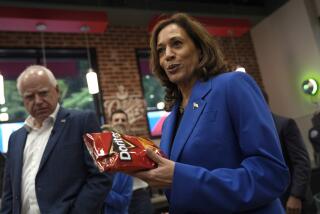Free-Market Economy Baffles Peruvians
- Share via
LIMA, Peru — Elvira Elguera wants to wash her hair. Store owner Ricardo Correa would love to sell her shampoo. But there will be no sale today. The shampoo has no price.
“Absurd!” Elguera declares as she stalks out of the shop.
“I don’t know what my costs are,” Correa tries to explain. “It’s better not to sell than to sell at a loss.”
Peruvians have lived for years under the shelter of price controls and subsidies. But when President Alberto Fujimori took office in July and 11 days later announced sweeping reforms, Peru took a dizzying leap into the economic unknown--a free-market economy.
Peruvians are baffled. Neither stores nor consumers seem to know what things should cost.
At first, prices soared: a pound of beans from 40 cents to $3, a bottle of beer from 33 cents to $4. But when sales lagged, many store owners dropped their prices.
Still, prices in one store can be five times higher than those in a shop across the street. And, as in Correa’s store, many products simply have no price.
“Chaos!” read a recent headline on the front page of a top Lima daily.
Even before the reforms, Peru’s economy was headed for disaster. Inflation averaged more than 3,000% a year and only one in five workers had a steady job.
The country’s gross national product has shrunk 20% since 1988.
Fujimori’s reforms were aimed at halting rising prices by drastically cutting consumption and closing a large fiscal deficit, caused in great part by subsidies. Previous governments have bridged the gap simply by printing more money.
“But the first 45 days of the plan will be tremendously recessive,” said Felipe Ortiz de Zevallos, an economist close to the government.
Government services such as telephone, water, light and fuel cost 10 to 30 times more. This has pushed prices sky-high throughout the economy. Inflation in August was nearly 400%, highest in Peru’s history.
Supermarkets are spilling over with unbought goods. Stores in luxury shopping centers are boarded up. Many factories are closed and others are preparing to shut.
“It’s no longer a matter of lowering prices. People just don’t have money,” said Carlos Chavez, whose men’s clothing store is full of sale signs. “The only thing anyone thinks about is eating.”
Graciela Elias’ shoe store hasn’t sold anything in days. “If things continue as they are, we’ll all go under,” she said.
The measures will kill off all but the most efficient companies, said Javier Silva Ruete, economy minister in a military government from 1978 to 1980.
The measures have left millions of Peruvians hungry. With wage increases far below inflation, they simply cannot afford sufficient food.
So far, there have been few violent protests. But just how long poor Peruvians will wait for any improvement is unknown.
The actions of wealthy industrialists may presage problems.
After the new measures were announced, Peru’s six main pharmaceutical manufacturers jointly raised prices six to 10 times. This put many life-saving medicines out of reach of all but the rich.
The prices have not dropped despite complaints even from Fujimori.
Silva Ruete said price-fixing by Peru’s many monopolies and oligopolies will continue until protectionist tariffs are reformed to allow imports to compete. Fujimori has promised such reforms, but so far there has been no change.
Even some retailers have trouble coming to terms with the ways of supply and demand.
“I don’t understand where my customers went,” said one restaurateur, staring at trays of pasta that he’s charging five times more for than before the reforms.
Across the street, a restaurant is packed. Prices there have only doubled.
Other retailers have adapted. Once dour market vendors now smile more often at prospective customers. Waiters seem more solicitous.
More to Read
Sign up for Essential California
The most important California stories and recommendations in your inbox every morning.
You may occasionally receive promotional content from the Los Angeles Times.










